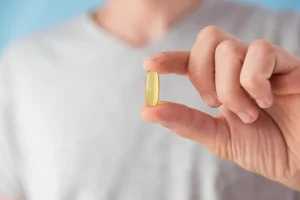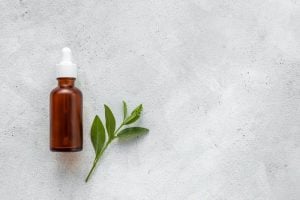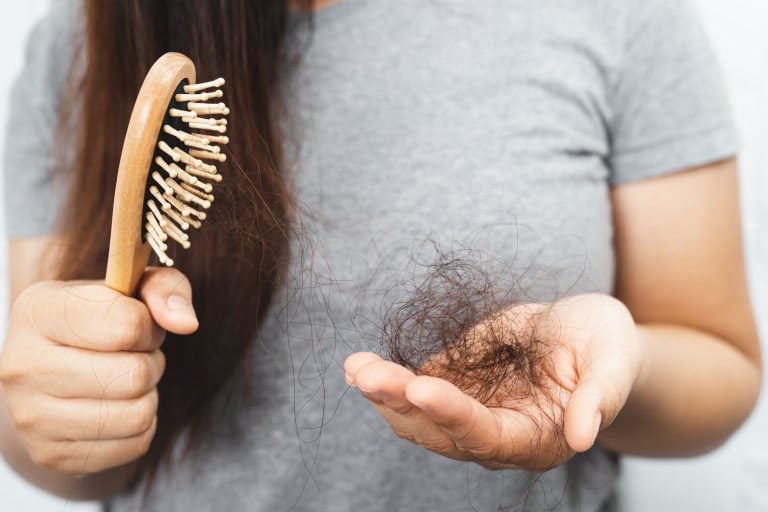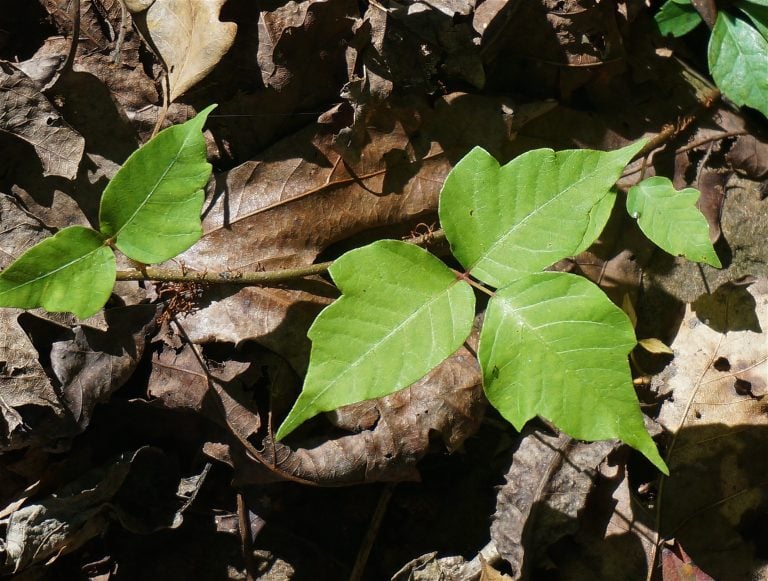Acne is often called a disease of Western civilization, largely due to the standard U.S. diet and high-stress lifestyles. Food and lifestyle undoubtedly influence skin, while hormones—less within our control—also contribute. These chemical messengers regulate growth, metabolism, mood, and sleep. With more than 50 different hormones at work, even slight imbalances can have a big impact on skin.1Baldwin H, Tan J. Effects of diet on acne and its response to treatment. Am J Clin Dermatol. 2021 Jan;22(1):55-65. Erratum in: Am J Clin Dermatol. 2021 Jan;22(1):67. https://doi.org/10.1007/s40257-020-00576-2
Acne often flares during adolescence, a time of surging hormones. But hormonal breakouts also happen later in life. Menstrual cycles, pregnancy, perimenopause, and menopause are catalysts for some women.
What causes hormonal breakouts?
It may seem obvious—hormonal fluctuations cause hormonal acne. But the reality is more complex. Genetics, bacteria, inflammation, and lifestyle play a part.
The role of genetics
If your parents or close relatives struggled with adult acne, you might be more prone to outbreaks too. Genetics influence everything from the size and function of oil glands to hormone levels and immune responses. Some people inherit an overactive immune response to acne triggers, like bacteria.1Bagatin E, Freitas THP de, Rivitti-Machado MC, et al. Adult female acne: a guide to clinical practice. An Bras Dermatol. 2019;94(1):62-75. doi:10.1590/abd1806-4841.20198203
Bacteria and inflammation
Cutibacterium acnes (previously Proprionibacterium acnes) bacteria live on the skin, particularly in oily areas. People with acne tend to have higher levels of C. acnes, which can trigger inflammation.1Bagatin E, Freitas THP de, Rivitti-Machado MC, et al. Adult female acne: a guide to clinical practice. An Bras Dermatol. 2019;94(1):62-75. doi:10.1590/abd1806-4841.20198203,2Bungau AF, Radu AF, Bungau SG, Vesa CM, Tit DM, Endres LM. Oxidative stress and metabolic syndrome in acne vulgaris: pathogenetic connections and potential role of dietary supplements and phytochemicals. Biomed Pharmacother. 2023;164:115003. doi:10.1016/j.biopha.2023.115003
Inflammation, the body’s natural defense against bacterial overgrowth, isn’t intrinsically problematic. However, when inflammation persists over time or becomes chronic, it can fuel the cycle of acne and lead to skin damage.1Bagatin E, Freitas THP de, Rivitti-Machado MC, et al. Adult female acne: a guide to clinical practice. An Bras Dermatol. 2019;94(1):62-75. doi:10.1590/abd1806-4841.20198203
Other acne triggers
Certain lifestyle and environmental factors don’t directly cause hormonal acne but can make it worse. These include1Bagatin E, Freitas THP de, Rivitti-Machado MC, et al. Adult female acne: a guide to clinical practice. An Bras Dermatol. 2019;94(1):62-75. doi:10.1590/abd1806-4841.20198203:
- Diet
- UV radiation exposure
- Stress
- Obesity
- Smoking
- Sleep disorders
- Cosmetics
- Medications
- High-glycemic foods
- Dairy
- Excessive skin washing
- Possible resistance to C. acnes2Bungau AF, Radu AF, Bungau SG, Vesa CM, Tit DM, Endres LM. Oxidative stress and metabolic syndrome in acne vulgaris: pathogenetic connections and potential role of dietary supplements and phytochemicals. Biomed Pharmacother. 2023;164:115003. doi:10.1016/j.biopha.2023.115003
- Endocrine disorders (such as PCOS, diabetes, and hypothyroidism)
Hormonal acne in women

Ever noticed that stress seems to trigger those pesky breakouts? That’s because it sparks the release of androgens, a group of male sex hormones (including testosterone). Androgens stimulate oil production, which can lead to clogged pores and acne.
Hormonal acne typically affects more women than men, especially during times when androgen levels rise, and estrogen levels decrease or fluctuate. During menstrual cycles, pregnancy, perimenopause, and menopause, women may notice acne worsen.1Bagatin E, Freitas THP de, Rivitti-Machado MC, et al. Adult female acne: a guide to clinical practice. An Bras Dermatol. 2019;94(1):62-75. doi:10.1590/abd1806-4841.20198203
In addition to testosterone, dehydroepiandrosterone sulfate (SDHEA, aka DHEA–S) and dihydrotestosterone (DHT) have also been shown to enlarge oil glands and increase oil production. Estrogen does the opposite, limiting oil gland growth, curbing oil production, and reducing the amount of androgen hormones released. The estrogen–androgen balance has a significant effect on hormonal acne. Although previous research showed that hormonal acne tends to crop up around the chin and mouth, more recent research shows it can appear on other parts of the face and back.1Bagatin E, Freitas THP de, Rivitti-Machado MC, et al. Adult female acne: a guide to clinical practice. An Bras Dermatol. 2019;94(1):62-75. doi:10.1590/abd1806-4841.20198203
How is hormonal acne typically treated?
Conventional treatments include topicals (retinoids, topical antibiotics, benzoyl peroxide, or azelaic acid) and systemic treatments (oral antibiotics, hormonal treatments, or isotretinoin). Commonly prescribed medications block androgen receptors, slow androgen production, or kill bacteria. However, many of these treatments come with side effects. Dryness and discomfort are common with retinol creams, while androgen blockers may cause menstrual changes, breast tenderness, headache, nausea, and fluid retention.1Bagatin E, Freitas THP de, Rivitti-Machado MC, et al. Adult female acne: a guide to clinical practice. An Bras Dermatol. 2019;94(1):62-75. doi:10.1590/abd1806-4841.20198203
Can you treat hormonal breakouts naturally?
Antioxidants help counter oxidative stress, which is strongly associated with acne. People with acne tend to have low levels of antioxidants (such as vitamins A, E, zinc, and selenium).2Bungau AF, Radu AF, Bungau SG, Vesa CM, Tit DM, Endres LM. Oxidative stress and metabolic syndrome in acne vulgaris: pathogenetic connections and potential role of dietary supplements and phytochemicals. Biomed Pharmacother. 2023;164:115003. doi:10.1016/j.biopha.2023.115003
Combining vitamin E and selenium has proven beneficial in reducing acne symptoms, while taking vitamin C and zinc together can improve antibiotic efficacy, especially against drug-resistant strains of C. acnes. Zinc (either alone or in combination with other therapies) reduces inflammation and androgen levels, diminishing oil production and alleviating hormonal acne symptoms.2Bungau AF, Radu AF, Bungau SG, Vesa CM, Tit DM, Endres LM. Oxidative stress and metabolic syndrome in acne vulgaris: pathogenetic connections and potential role of dietary supplements and phytochemicals. Biomed Pharmacother. 2023;164:115003. doi:10.1016/j.biopha.2023.115003
Vitamin D and acne prevention

Vitamin D helps prevent acne lesions, reduces oil production, keeps pores clear, and controls bacterial growth. In a study involving 100 acne patients, those who received vitamin D treatment reported skin improvements and reduced inflammation. Another study of 160 people with acne revealed that nearly half had low vitamin D levels. When participants supplemented with 1,000 IU of vitamin D daily for two months, they saw a significant reduction in acne-related inflammation.2Bungau AF, Radu AF, Bungau SG, Vesa CM, Tit DM, Endres LM. Oxidative stress and metabolic syndrome in acne vulgaris: pathogenetic connections and potential role of dietary supplements and phytochemicals. Biomed Pharmacother. 2023;164:115003. doi:10.1016/j.biopha.2023.115003
Herbal supplements for hormonal acne
Certain herbs help balance hormones and may improve hormonal acne. Chaste tree (Vitex agnus-castus) and saw palmetto (Serenoa repens) are particularly beneficial.2Bungau AF, Radu AF, Bungau SG, Vesa CM, Tit DM, Endres LM. Oxidative stress and metabolic syndrome in acne vulgaris: pathogenetic connections and potential role of dietary supplements and phytochemicals. Biomed Pharmacother. 2023;164:115003. doi:10.1016/j.biopha.2023.115003
Bittersweet (Solanum dulcamara) and “old man’s beard” (Usnea barbata) are known for their antimicrobial properties. Eucommia ulmoides, commonly used in traditional Chinese medicine, inhibits C. acnes and reduces inflammation. Similarly, amla, a staple in Ayurvedic medicine, protects skin cells from free radical damage.2Bungau AF, Radu AF, Bungau SG, Vesa CM, Tit DM, Endres LM. Oxidative stress and metabolic syndrome in acne vulgaris: pathogenetic connections and potential role of dietary supplements and phytochemicals. Biomed Pharmacother. 2023;164:115003. doi:10.1016/j.biopha.2023.115003
Several plant extracts also show promise in managing hormonal acne.
- Berberine, derived mainly from Berberis vulgaris L., has potent anti-inflammatory and antioxidant properties. It helps prevent excessive testosterone production and reduces oil secretion.2Bungau AF, Radu AF, Bungau SG, Vesa CM, Tit DM, Endres LM. Oxidative stress and metabolic syndrome in acne vulgaris: pathogenetic connections and potential role of dietary supplements and phytochemicals. Biomed Pharmacother. 2023;164:115003. doi:10.1016/j.biopha.2023.115003
- Curcumin, the active compound in Curcuma longa L., has been used in traditional Indian and Chinese medicine for centuries. Its antibacterial and antioxidant effects make it effective in limiting C. acnes overgrowth.2Bungau AF, Radu AF, Bungau SG, Vesa CM, Tit DM, Endres LM. Oxidative stress and metabolic syndrome in acne vulgaris: pathogenetic connections and potential role of dietary supplements and phytochemicals. Biomed Pharmacother. 2023;164:115003. doi:10.1016/j.biopha.2023.115003
- Quercetin, a plant nutrient found in fruits, vegetables, and Chinese herbal medicine, has anti-inflammatory and antibacterial properties. Research suggests it not only reduces inflammation but also strengthens the immune system, which may help the body manage C. acnes more effectively.3Zhao D, Wang Y, Wu S, et al. Research progress on the role of macrophages in acne and regulation by natural plant products. Front Immunol. 2024;15:1383263. doi:10.3389/fimmu.2024.1383263
- Baicalin, extracted from Scutellaria baicalensis, is widely used in traditional Chinese medicine. Studies confirm its anti-inflammatory and antioxidant effects, which may help alleviate acne symptoms.3Zhao D, Wang Y, Wu S, et al. Research progress on the role of macrophages in acne and regulation by natural plant products. Front Immunol. 2024;15:1383263. doi:10.3389/fimmu.2024.1383263
- Schisandrin, found in Schisandra chinensis, has been shown to reduce oxidative stress and inflammation.3Zhao D, Wang Y, Wu S, et al. Research progress on the role of macrophages in acne and regulation by natural plant products. Front Immunol. 2024;15:1383263. doi:10.3389/fimmu.2024.1383263
Essential oils

Essential oils with antimicrobial, anti-inflammatory, and antioxidant properties have shown promise in hormonal acne treatment. Research highlights four potent essential oils for controlling C. acnes2Bungau AF, Radu AF, Bungau SG, Vesa CM, Tit DM, Endres LM. Oxidative stress and metabolic syndrome in acne vulgaris: pathogenetic connections and potential role of dietary supplements and phytochemicals. Biomed Pharmacother. 2023;164:115003. doi:10.1016/j.biopha.2023.115003:
- Citronella oil
- Oregano oil
- Thyme oil
- Basil oil
Tea tree oil demonstrated moderate effectiveness, while rosemary and lavender oils may help counter oxidative stress.2Bungau AF, Radu AF, Bungau SG, Vesa CM, Tit DM, Endres LM. Oxidative stress and metabolic syndrome in acne vulgaris: pathogenetic connections and potential role of dietary supplements and phytochemicals. Biomed Pharmacother. 2023;164:115003. doi:10.1016/j.biopha.2023.115003
Essential oils are highly concentrated plant extracts that can be too potent to apply directly to the skin. To ensure safe use, they should always be diluted in a carrier oil—such as coconut, jojoba, or almond oil—before application. Dilution reduces the risk of irritation, allergic reactions, and skin sensitivity. Always conduct a patch test before widespread use, and consult a professional for guidance, especially if you have sensitive skin or underlying conditions.
Lifestyle and dietary changes for healthier skin

Smoking, chronic stress, and consistently poor sleep can all affect hormone balance and skin health. Although there are many potential root causes of acne, keeping a regular skincare routine can help keep breakouts in check:
- Keep skin clean. Wash your face gently twice a day or after sweating to remove excess sebum. Use a gentle cleanser and avoid washcloths and sponges, which can irritate skin.
- Choose the right products. Check labels for terms like “gentle” and “alcohol free.” Avoid astringents, toners, and exfoliants, which can dry out and irritate skin, worsening acne.
- Try not to touch. Tempting as it may be, touching your face frequently can cause acne to flare. Avoid picking, popping, and squeezing to clear breakouts faster and reduce scarring and dark spots.4Goodman G. Cleansing and moisturizing in acne patients. Am J Clin Dermatol. 2009;10 Suppl 1:1-6. doi:10.2165/0128071-200910001-00001
Western diets tend to be laden with omega–6 fatty acids and not enough omega–3s. Fatty acid imbalances and overconsumption of dairy products, refined carbs, and saturated fats can contribute to inflammation and acne. The combination of high dairy product consumption and high glycemic index foods, in particular, affects hormones involved in acne development. This way of eating also disturbs the gut microbiome, which is directly tied to skin health.4Ryguła I, Pikiewicz W, Kaminiów K. Impact of diet and nutrition in patients with acne vulgaris. Nutrients. 2024;16(10):1476. doi:10.3390/nu16101476
Avoiding certain foods and beverages may help mitigate hormonal acne:4Ryguła I, Pikiewicz W, Kaminiów K. Impact of diet and nutrition in patients with acne vulgaris. Nutrients. 2024;16(10):1476. doi:10.3390/nu16101476
- Alcohol
- Dairy
- Chocolate and sweets
- Salty foods
- Gluten
- Corn
- Soft drinks
Achieving optimal hormone balance starts with a nourishing diet. Incorporating cruciferous vegetables like broccoli, kale, and cabbage can help clear excess hormones,5Manchali S, Murthy K, Patil BS. Crucial facts about health benefits of popular cruciferous vegetables. J Funct. Foods. 2012;4:94-106. doi:10.1016/j.jff.2011.08.004 while lean proteins such as beans, chicken, fish, and turkey provide essential building blocks for hormone production.6Ekberg NR, Catrina SB, Spégel P. A protein-rich meal provides beneficial glycemic and hormonal responses as compared to meals enriched in carbohydrate, fat or fiber, in individuals with or without type-2 diabetes. Front Nutr. 2024 Jul 4;11:1395745. doi:10.3389/fnut.2024.1395745 These nutrient-dense foods provide a foundation for clearer skin and long-term hormonal health.
Footnotes
- 1Bagatin E, Freitas THP de, Rivitti-Machado MC, et al. Adult female acne: a guide to clinical practice. An Bras Dermatol. 2019;94(1):62-75. doi:10.1590/abd1806-4841.20198203
- 2Bungau AF, Radu AF, Bungau SG, Vesa CM, Tit DM, Endres LM. Oxidative stress and metabolic syndrome in acne vulgaris: pathogenetic connections and potential role of dietary supplements and phytochemicals. Biomed Pharmacother. 2023;164:115003. doi:10.1016/j.biopha.2023.115003
- 3Zhao D, Wang Y, Wu S, et al. Research progress on the role of macrophages in acne and regulation by natural plant products. Front Immunol. 2024;15:1383263. doi:10.3389/fimmu.2024.1383263
- 4Ryguła I, Pikiewicz W, Kaminiów K. Impact of diet and nutrition in patients with acne vulgaris. Nutrients. 2024;16(10):1476. doi:10.3390/nu16101476
- 5Manchali S, Murthy K, Patil BS. Crucial facts about health benefits of popular cruciferous vegetables. J Funct. Foods. 2012;4:94-106. doi:10.1016/j.jff.2011.08.004
- 6Ekberg NR, Catrina SB, Spégel P. A protein-rich meal provides beneficial glycemic and hormonal responses as compared to meals enriched in carbohydrate, fat or fiber, in individuals with or without type-2 diabetes. Front Nutr. 2024 Jul 4;11:1395745. doi:10.3389/fnut.2024.1395745





